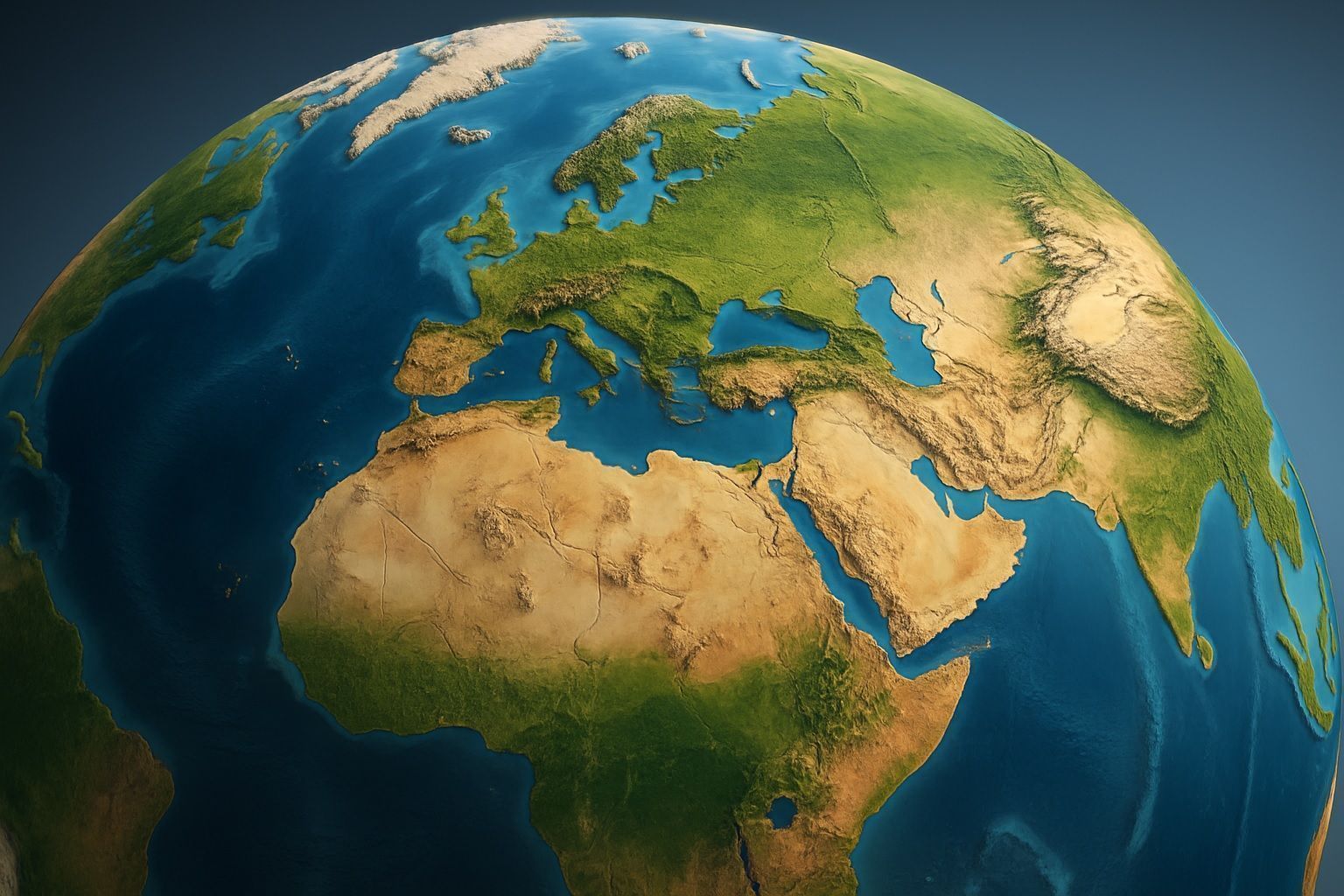- CO3D comprises four identical S250-based satellites, each weighing about 250–300 kg with 100% electric propulsion, delivering ~50 cm spatial-resolution optical imagery.
- It aims to produce a global Digital Surface Model with ~1 m vertical accuracy and to map ~40 million km² of Earth’s land per year in 3D.
- The system targets roughly 90% of the globe’s land areas between ±70° latitude to be mapped within five years.
- Satellites operate in two pairs on opposite sides of Earth, with ~100 km separation in the same orbit plane to enable synchronized stereo imaging.
- The four-satellite launch is planned for 25 July 2025 from Kourou on a Vega-C rocket with the Clessidra dispenser, carrying also the MicroCarb CO₂ payload.
- The mission includes LASIN, an inter-satellite laser communication demonstrator, achieving data downlinks up to 10 Gbps.
- Onboard AI processing lets customers upload and run AI models in space for real-time feature extraction, such as ship detection, before downlink.
- CO3D features low-light imaging capabilities, enabling longer exposures and nighttime observations beyond typical optical satellites.
- Ground processing is cloud-based, ingesting stereo imagery and using CNES photogrammetry tools to produce DSMs and orthoimagery, handling tens of terabytes of imagery daily with reduced latency.
- In the geospatial market, CO3D complements Maxar’s 30 cm WorldView Legion and Planet’s daily 2D coverage, offering global 3D mapping at ~1 m DSM accuracy as a Europe-backed dual-use program with CNES and IGN involvement.
Airbus’s Constellation Optique 3D (CO3D) is a cutting-edge Earth observation project poised to revolutionize how we map and monitor the planet. Set for launch in July 2025, CO3D is a constellation of four laser-linked, AI-enabled optical satellites that will deliver 50 cm resolution imagery and generate a global 3D map of Earth’s land surfaces [1] [2]. Developed in partnership with the French Space Agency (CNES), this dual-use system (serving both civilian and defense needs) promises unprecedented detail and timeliness in geospatial data. From advanced optical sensors to onboard artificial intelligence and inter-satellite laser communications, CO3D brings a host of innovations that could make it a game changer in Earth observation [3]. Below, we delve into the project’s history, technical features, applications, and how it stacks up against other players like Maxar and Planet Labs, as well as analogous missions from NASA.
Project Overview: History and Purpose
The CO3D program traces its origins to 2019, when CNES selected Airbus Defence & Space to build a new constellation to succeed the stereo imaging capability of the French Pléiades satellites [4]. Pléiades (launched in 2011–2012) provided high-resolution 2D and limited 3D imagery, but CO3D is designed to take this further by covering the entire globe in three dimensions with much higher fidelity [5]. Under the contract, Airbus is tasked with delivering a global high-resolution Digital Surface Model (DSM) – essentially a precise 3D map of Earth’s land terrain [6] [7]. The project is a partnership between Airbus and CNES (with France’s mapping agency IGN also involved [8]), ensuring that both commercial objectives and public needs are met through a “virtuous partnership” and integrated governance [9]. Notably, data from CO3D will be made available not just to paying customers but also to scientific and defense institutions, reflecting its dual-use nature [10].
Launch and funding: Originally slated for launch by 2023, CO3D faced some delays (in part due to schedule slips of the Vega-C launch vehicle). By late June 2025, the four satellites were en route from Airbus’s Toulouse facility to the European Spaceport in Kourou, French Guiana, for a launch on July 25, 2025 aboard a Vega-C rocket [11]. CNES secured a launch contract with Arianespace back in 2020 for this mission [12] [13]. Once in orbit, the CO3D satellites will join Airbus’s existing fleet of optical and radar satellites (such as the sub-30 cm resolution Pléiades Neo and the TerraSAR-X radar constellation), strengthening the company’s ability to meet growing demand for very high-resolution imagery [14] [15]. As Jean-Marc Nasr, then Head of Space Systems at Airbus, said at the project’s inception: “CO3D is a significant leap forward for global Earth observation, taking advantage of the latest Airbus innovations which will revolutionize access to very high-resolution 3D data.” [16] This bold vision highlights the program’s core purpose: to dramatically improve access to sub-meter 3D geospatial information on a worldwide scale.
Mission goals: The primary goal of CO3D is to produce a global digital surface model with ~1 m vertical accuracy within a few years [17]. By imaging the same areas from different angles, the satellites will use stereoscopic vision to derive 3D elevation data. According to CNES, the plan is to cover about 40 million km² of Earth’s land surface per year in 3D – an unprecedented rate for such high detail [18]. At that pace, approximately 90% of the globe’s land areas (between roughly ±70° latitude) would be mapped in five years [19]. This represents a huge improvement over previous global elevation datasets (for comparison, NASA’s SRTM radar mission in 2000 produced a 30 m resolution DEM [20]). The CO3D data will serve both military needs for precise, up-to-date cartography and myriad civil applications ranging from urban planning and infrastructure development to resource management and disaster response [21]. In short, CO3D’s purpose is to provide frequent, high-precision 3D mapping of Earth to anyone from defense planners to climate scientists – a capability not available at this scale until now.
Technical Innovations and Key Features
CO3D introduces several state-of-the-art technologies in its compact satellites. Each satellite is based on Airbus’s new “S250” smallsat platform – a highly agile, all-electric design that benefits from Airbus’s experience mass-producing satellites (for example, the OneWeb telecom constellation) [22]. Below are some of the key innovations and specifications that make CO3D stand out:
- High-Agility, Electric Propulsion: The CO3D satellites weigh only ~250–300 kg each yet are equipped with 100% electric propulsion for orbit control [23] [24]. They also feature a new generation of reaction wheels giving them exceptional agility [25]. This allows rapid reorientation to capture stereo pairs and targets of opportunity. The four satellites will operate in pairs on opposite sides of Earth, with two spacecraft flying ~100 km apart in the same orbit plane for synchronized stereo imaging [26].
- 50 cm Optical Imaging & 3D Stereo: Each CO3D satellite carries a unique optical instrument capable of ~50 cm spatial resolution imaging in the visible red, green, blue, and near-infrared bands [27]. By simultaneously photographing an area from two different angles (using the two satellites in a pair), CO3D can generate stereo imagery that is later processed into 3D elevation models. The system is designed to achieve about 1 m relative vertical accuracy in its DSMs (and ~2 m absolute accuracy) with a post spacing of 1 m [28]. This is a major leap in precision for global 3D data – previous world DEMs (like SRTM) had 30 m pixels [29]. Thanks to the two pair/four satellite configuration, CO3D will also have improved revisit frequency and can even do simultaneous stereo captures of moving objects (e.g. vehicles, waves) by having two satellites image the same spot at the exact same time [30].
- Laser Communications (Inter-satellite & Downlink): One of the CO3D satellites is hosting a demonstrator called LASIN – an optical laser communication system developed with CNES [31]. This will test high-speed data downlinks to a laser ground station, achieving throughput up to 10 Gbps (roughly 10× faster than traditional X-band radio downlinks) [32]. Such laser links could later enable rapid data relay between satellites or directly to ground, an important feature as imaging constellations collect ever-larger volumes of data.
- Onboard AI Processing: Uniquely, CO3D is an “AI-enabled” constellation. The satellites are designed to let customers upload and run applications on-board, including artificial intelligence or deep learning algorithms [33]. In practice, this means a user could send up a trained model (for example, a ship detection algorithm), and the satellite will process its own imagery in real-time to detect and extract specific features (like vessels or aircraft) before sending data down [34]. This saves bandwidth and time by downlinking only the insights needed, rather than raw imagery. CNES is leading a first demonstration of this capability, which marks a step toward edge computing in space.
- Low-Light “Night Vision” Imaging: CO3D will also “see in the dark” better than typical optical satellites. Its high-performance sensor has a special noise-reduction mode that, combined with an innovative attitude control mode, allows the satellite to take longer exposures over a target [35]. Essentially, CO3D can dwell and collect more light from a dim scene. This enables capturing images in low-light conditions – for example, observing urban areas at night or other dark regions – something standard Earth observation satellites struggle with [36]. While it won’t match a true night-vision device, this capability extends CO3D’s usable imaging times beyond daylight, which is valuable for certain applications (like monitoring city lights or maritime vessels at night).
- Cloud-Based Ground Processing: On the ground, Airbus is deploying a cloud-based processing system that ingests CO3D’s stereo imagery and automatically converts it into 3D maps [37]. This pipeline integrates advanced photogrammetry algorithms provided by CNES to rapidly produce the DSMs and orthoimagery. The goal is to minimize the lag between image acquisition and delivery of 3D data to end users [38]. By leveraging cloud compute and automation (including AI for quality control), Airbus aims to handle the enormous data volume (CO3D will produce tens of terabytes of imagery daily) and serve both commercial customers and government users with on-demand 3D data.
Collectively, these innovations make CO3D a pioneering system. It embodies the trends of miniaturization, automation, and AI in Earth observation, packing what once would require a one-ton satellite into a 300 kg class spacecraft with smarter capabilities. Airbus also leveraged production techniques from large constellations – the CO3D satellites were built using an assembly line in Toulouse inspired by automotive/aerospace series production, with standardized components and digitalized operations [39]. This industrial approach helps contain costs and could allow scaling up the constellation in the future. (Airbus has hinted that the CO3D system could be expanded to dozens of satellites if demand warrants, since the platform is modular and production lines are in place [40].)
Constellation Deployment and Launch Details
The CO3D constellation consists of four identical satellites that will operate in a coordinated orbit to maximize 3D coverage and revisit. They will be deployed into a sun-synchronous polar orbit at ~502 km altitude [41]. This orbit allows consistent lighting conditions (imaging around 10:30 AM local solar time) which is ideal for optical imaging. The satellites are paired such that two will orbit on one side of Earth and two on the opposite side, effectively giving a balanced coverage around the globe [42]. Within each pair, the two satellites fly about 100 km apart along the same orbital track [43]. This separation is deliberate – when they simultaneously image the same area, that slight offset yields the stereoscopic parallax needed for 3D reconstruction (like having a pair of eyes in space). The operational lifetime is designed for at least 6–8 years of service [44] [45], so this initial quartet could sustain mapping through 2030 and beyond.
Launch vehicle: All four satellites are being launched together on a single Arianespace Vega-C rocket. The Vega-C (a light lift European launcher) has been fitted with a special multi-satellite dispenser (nicknamed Clessidra) to accommodate the quartet in one go [46]. The launch is scheduled for 25 July 2025 at 22:03 local time in Kourou (01:03 UTC on 26 July) [47]. In late June 2025, Airbus confirmed the satellites had been shipped to the spaceport in French Guiana for final launch preparations [48]. Along for the ride is a secondary payload: the MicroCarb satellite – a small CNES/UK mission to measure atmospheric CO₂ for climate research [49]. Vega-C will deploy CO3D and MicroCarb into their respective orbits, demonstrating the launcher’s capability to loft multiple modern smallsats.
After launch, the CO3D satellites will undergo a 6-month in-orbit commissioning and calibration period [50]. During this time, engineers will test the stereo imaging, adjust the orbital phasing of the satellites, activate the laser communication demo, and validate the ground processing chain. By early 2026, CO3D is expected to begin its “demonstration phase” of operations [51]. The first major target is to produce a full 3D map of France and the “crisis arc” region within 18 months of commissioning [52]. (The “crisis arc” refers to areas of strategic interest to France, likely encompassing parts of Europe, Africa, and the Middle East.) This deliverable to CNES by mid-2027 will prove the system’s capabilities [53]. After that, CO3D will enter its commercial phase, wherein the satellites’ capacity can be tasked for other mapping projects and customer imagery requests [54].
It’s worth noting that CO3D’s capacity is very high for a four-satellite network. The system is designed to acquire stereo image data covering ~40 million km² per year for DSM production [55]. If needed, Airbus could potentially launch additional satellites to increase coverage frequency or maintain the service as original units age. The underlying satellite bus and ground segment are built to be scalable – indeed, Airbus initially contemplated that a fully scaled constellation could involve 20 or more satellites in the CO3D family over time [56]. For now, the four satellites will substantially boost Airbus’s imagery offerings when combined with the existing Pléiades and radar satellites. Together with the four Pléiades Neo satellites, CO3D will enable “unrivalled refresh rates” for very high-resolution imagery, according to Airbus [57]. In essence, users will not only get finer detail (50 cm and 3D) but also more frequent updates, which is crucial for time-sensitive applications.
Applications: Commercial, Defense, and Climate Monitoring
One of CO3D’s strengths is its versatility – the data it gathers will be valuable across multiple sectors. Here we outline key application areas and use cases:
- Defense and Intelligence: Military planners and intelligence agencies have a constant need for up-to-date, accurate maps and surveillance imagery. CO3D’s 50 cm resolution and 3D capability will support tasks like mission planning, terrain analysis for operations, line-of-sight assessments, and target coordinate extraction. In modern warfare and reconnaissance, having a precise 3D model of the environment can greatly enhance situational awareness. French defense stakeholders in particular are eager for CO3D’s data to replace older mapping sources with higher fidelity [58]. “Analyzing and understanding satellite imagery has become a prerequisite to inform decisions… [We] can use it to compile a map, extract a 3D view, measure lengths and distances or identify features,” explains Alain Gleyzes, CNES’s deputy director of Earth observation projects [59]. This underlines how 3D imagery is a force multiplier for IMINT (imagery intelligence). CO3D’s dual-use nature means its data will be shared with France’s defense ministry and allies, enabling better cartography for military operations, border monitoring, and crisis response. The constellation’s rapid revisit (daily global coverage in 2D, and frequent 3D updates of key areas) is especially useful for monitoring developments in contested regions or disaster zones.
- Civil & Commercial Uses: High-resolution 3D maps have enormous value for civil engineering, urban planning, and infrastructure development. City planners can use CO3D-derived models to plan new transportation routes or assess line-of-sight for telecom towers. Construction and mining companies can survey sites remotely in 3D, tracking progress or volumes without sending crews. CO3D’s DSMs (digital surface models) will also aid mapping agencies (like IGN in France) in updating national topographic maps and creating detailed 3D city models. Because the data will be kept current (with wide areas remodeled every few months in some cases [60]), it can serve as a live digital twin of the Earth’s surface. Commercial GIS platforms and location-based services could integrate this data for anything from real estate visualization to autonomous vehicle navigation maps. Airbus expects that CO3D will “open up new perspectives for start-ups or established companies” to build applications on top of the 3D data [61]. For example, a startup might use CO3D models to develop VR environments or to plan optimal drone flight paths in complex terrain. The combination of 2D imagery and 3D elevation from the same source is especially powerful for civil uses – one can identify objects in the high-res image and know their height above ground precisely.
- Climate and Environmental Monitoring: CO3D’s capabilities are also a boon for environmental science and climate-related applications. The system can monitor changes in Earth’s surface over time with fine detail, which is crucial for tracking climate change impacts. For instance, glaciologists and snow hydrologists will be able to get frequent 3D updates of glaciers, ice caps, and snow cover [62]. By comparing elevation models over time, they can measure ice melt and seasonal snowpack changes with ~1 m accuracy – offering insights into sea-level rise contributions and water resources. CO3D can also help map coastal erosion, deforestation (through changes in canopy height), volcanic activity (inflation or collapse of terrain), and the aftermath of natural disasters. In disaster response, having a fast 3D picture of an area hit by, say, an earthquake or landslide allows responders to assess damage and plan relief logistics (e.g. determining where roads are cut off by landslides by looking at the 3D terrain). Furthermore, the fact that CO3D can attempt imaging in low-light conditions means it might capture nighttime environmental phenomena (like wildfires’ glow or urban power outages) that others might miss. While CO3D itself is optical (and thus can’t see through clouds), it complements other sensors like radar; for example, an interferometric radar mission could detect ground subsidence and CO3D could then provide a high-res 3D view of the area on the next clear day. The climate monitoring relevance of CO3D is underscored by its joint launch with MicroCarb, the CO₂-mapping satellite [63]. Together, these missions highlight how France and Airbus are targeting both the physical aspects of climate change (via 3D mapping) and the atmospheric composition aspects (via CO₂ measurements). In summary, CO3D’s data will support environmental monitoring from the tracking of glaciers and water levels to forestry management and geological studies.
CO3D vs. Other Earth Observation Programs
CO3D arrives at a time of rapid advancement in Earth observation, and it faces both collaboration and competition from other players. Here’s how it compares to offerings from major industry and government programs:
- Maxar Technologies (WorldView Satellites): Maxar (formerly DigitalGlobe) is a key competitor, operating a fleet of very high-resolution imaging satellites. In 2024–2025 Maxar launched its new WorldView Legion constellation, which delivers 30 cm-class resolution imagery (slightly sharper detail than CO3D’s 50 cm) for 2D surveillance. With six Legion satellites in orbit, Maxar can collect over 5 million km² of imagery per day at 30 cm resolution [64], providing frequent revisits (up to 15 times per day for certain targets) to its customers. Maxar’s focus has traditionally been on 2D imagery, but it also produces 3D geospatial products by processing stereo pairs from its archives. For example, Maxar’s Precision3D product suite offers 50 cm resolution 3D models derived from satellite photos, with about 3 m absolute accuracy in elevation. However, these 3D models are generated offline and on-demand, whereas CO3D is purpose-built to systematically map the globe in 3D with ~1 m relative accuracy [65]. In essence, Maxar’s Legion constellation excels at high-frequency, ultra-high-res imaging (ideal for spying a new development or tracking change day-to-day), while CO3D aims to provide a global foundational layer of 3D data at slightly lower spatial resolution but with consistent coverage and metric accuracy. It’s conceivable that many users will use these datasets in tandem – e.g. Maxar’s 30 cm pictures to identify objects, and CO3D’s 3D model to measure their height or terrain context. Maxar and Airbus also differ in business model: Maxar’s imagery (including 3D) is largely sold commercially (and to the U.S. government), whereas CO3D’s output, supported by the French government, will be available to French public agencies and partners in addition to commercial clients [66].
- Planet Labs: Planet operates the largest fleet of earth observation satellites in the world by count, with hundreds of nano-satellites (the Dove CubeSats) imaging the Earth daily at 3–5 m resolution. In contrast to CO3D’s focus on high resolution and 3D, Planet’s hallmark is daily global coverage in medium resolution – essentially a frequently updated “living map” of Earth in 2D. For higher resolution needs, Planet also has a fleet of 50 cm capability satellites: the SkySat series (acquired from Google Terra Bella) can provide 50 cm imagery with up to 12× revisit per day for targeted areas [67]. However, Planet’s SkySats are fewer in number (around 15 operational) and mainly tasked for monitoring specific sites rather than wall-to-wall mapping. Planet does not currently generate a global 3D model; their value proposition is more about high revisit monitoring (e.g. tracking agricultural changes, monitoring every port in the world daily, etc.). In a way, Planet’s data could complement CO3D: Planet can tell you where change is happening (e.g. detecting that a new building has appeared via daily images), and then CO3D can be tasked to fly a stereo pair over that spot to provide a detailed 3D view of the change. It’s also worth noting that Planet’s imagery is used in conjunction with machine learning a lot – something CO3D is also enabling via its onboard AI. Both Planet and CO3D reflect the trend of increasing automation in imagery analysis, but they operate at different ends of the resolution spectrum. From a market standpoint, Planet’s subscription model for broad coverage and Airbus’s premium 3D product are different offerings, and savvy geospatial analysts may use both to get the job done.
- NASA & Public Missions: Government-funded Earth observation missions by agencies like NASA (USA), ESA (Europe), and others traditionally focus on free and open data at moderate resolutions or very specialized measurements, rather than the very-high-resolution commercial imagery that CO3D provides. For example, NASA’s workhorse mapping missions have been Landsat (30 m resolution optical imagery, global coverage every 16 days) and ASTER (15–30 m imagery with stereo capability, which produced a global DEM at ~30 m resolution). The most comparable global 3D dataset to CO3D’s product is the Shuttle Radar Topography Mission (SRTM), a one-time radar mapping in 2000 that yielded a ~30 m resolution elevation model of most of the Earth [68] (later improved to 30 m globally). CO3D’s 0.5 m imagery and 1 m DSM accuracy vastly outstrip these in detail. However, agencies like NASA are more concerned with science and climate observations: for instance, NASA’s ICESat-2 uses a laser altimeter to measure ice sheet thickness and forest canopy heights (with centimeter precision but only along narrow tracks), and ESA’s Sentinel-1 radar can measure ground deformation to the millimeter (great for geophysics, but at 10 m spatial resolution). Those missions complement but do not replace the need for high-res mapping. In fact, NASA and others increasingly purchase commercial imagery for research (through programs like NASA’s Commercial Smallsat Data Acquisition) because they have no equivalent in-house source for 50 cm-class data [69]. Where public missions excel is in open data and continuity – e.g., the EU’s Copernicus program provides free Sentinel satellite data (10 m optical, 20 m DEM from Sentinel-1 radar) which is widely used as a base layer. CO3D, being a commercial+government hybrid, will produce data that might be selectively open (for French public use or scientific projects) but largely commercially licensed globally. In summary, NASA/ESA missions provide the global context and long-term climate records, while CO3D and its private-sector peers provide the fine-grained details and on-demand mapping that the public systems can’t. The combination of both will give users an unprecedented range of scales to work with – from continental trends down to street-level 3D maps.
Significance and Outlook in the Geospatial Data Era
Beyond its technical specs and commercial plans, CO3D signals a broader shift in the geospatial industry toward integrated, intelligent mapping of our planet. By combining high-resolution observation, rapid processing, and AI analytics, CO3D is essentially turning raw imagery into actionable information faster and more efficiently. This holds great significance in an era when “near-real-time digital twins” of Earth are becoming feasible and highly valuable.
Industry experts note that we are entering a “golden age” of Earth observation, fueled by both technology and demand. The global market for Earth observation data is projected to grow from around $6.1 billion in 2023 to over $9 billion by 2028 (roughly 8–9% yearly growth) [70]. Driving this is an “urgent need for climate and security data” [71] – exactly the needs CO3D was designed to address. High-resolution 3D maps can inform climate adaptation strategies (e.g. where to build sea walls or how permafrost thaw is affecting infrastructure), and they are indispensable for modern defense and intelligence as discussed. AI-driven mapping is another rising trend: instead of just pictures, users want insights (like “find all the new buildings in this city” or “where are there signs of flood damage”). CO3D’s onboard AI experiment is a glimpse of the future where satellites might autonomously monitor certain cues (say, detecting ships in open ocean) and alert users immediately. This reduces the burden of shipping huge volumes of data to ground and having analysts or algorithms sift through it – the satellite becomes the first line analyst. We can expect future constellations (from Airbus or competitors) to expand on this concept, especially as in-orbit computing power increases.
From a strategic standpoint, CO3D also exemplifies Europe’s effort to secure independent geospatial intelligence. Until now, the highest resolution commercial data (30 cm imagery, etc.) was dominated by U.S. companies like Maxar, subject to U.S. regulations. CO3D (along with Pléiades Neo) gives Europe its own source of 50 cm and finer imagery, plus unique 3D capabilities, ensuring that European governments and companies are not entirely reliant on foreign providers for critical mapping data. It’s a move somewhat analogous to how Galileo provides Europe an independent GPS – CO3D provides an independent stream of high-grade 3D earth information. The fact that CO3D’s development was supported by CNES and its data will feed into French government use shows the importance of this capability for national and regional security [72].
Airbus, for its part, is positioning itself as a one-stop shop for Earth observation: it now will have sub-30 cm 2D imaging (Pléiades Neo), 50 cm stereo 3D (CO3D), radar imaging (TerraSAR-X, Tandem-X, etc.), and even greenhouse gas monitoring (via MicroCarb, Merlin, etc.). The CO3D program also helped Airbus refine its satellite production techniques, which could lower costs for future missions [73]. If CO3D’s model is successful, we might see follow-on constellations or even an expansion of CO3D itself (there is nothing stopping Airbus from building CO3D 5–8 or a second generation, especially if international partners or commercial customers invest in more capacity). Global 3D mapping might also become a more common offering – for instance, we may see partnerships where CO3D data is fused with other sources to create continually updating 3D maps (already, companies like Google and Microsoft use aerial imagery and street-level data to make 3D city maps; one can imagine them integrating satellite 3D for areas where airborne surveys are impractical).
In the context of geospatial data’s future, CO3D is a significant step toward a world where we have a “digital twin” of Earth that is accurate to the meter, updated in near-real-time, and accessible on demand. Such a capability will support everything from autonomous navigation systems to precision agriculture, climate modeling, and beyond. It also raises considerations about data policy: who has access to this detailed 3D data, and how to ensure it is used responsibly (for example, in military contexts or for protecting privacy). As of now, much of CO3D’s output will be commercial or government-controlled, but the insights derived could trickle down to the public through services and applications built on top of it.
Airbus officials have expressed strong confidence in CO3D’s impact. “CO3D is not only a step up in operational capability, it is also a game changer in terms of technological, industrial and commercial innovations,” said Alain Fauré, Airbus’s Head of Space Systems, emphasizing the program’s pioneering nature [74]. By bringing together French government support, Airbus engineering, and the latest in space tech, CO3D exemplifies what next-generation earth observation is all about. In summary, CO3D’s launch marks a milestone: the dawn of truly global, high-resolution 3D mapping powered by AI and newspace agility. Its success could very well reshape the landscape of geospatial intelligence and mapping – giving us new eyes in the sky that see the world in rich three dimensions, and in doing so, helping us manage and understand our planet better than ever before.
Sources:
- Airbus, “New generation Airbus-built optical constellation CO3D satellites en route for launch” (Press Release, 26 June 2025) [75] [76]
- Airbus, CO3D Earth Observation Portfolio – Project description and specs [77] [78]
- CNES, CO3D project overview (Updated 17 June 2025) [79] [80]
- CNES, Key milestones for CO3D [81] [82]
- SatNews, “Airbus + CNES Developed CO3D Constellation Launch To Be Handled By Arianespace” (Dec 8, 2020) [83]
- Military Aerospace, “Airbus to develop CO3D Earth Observation program for CNES” (Jul 9, 2019) [84]
- AInvest News, “Airbus’ CO3D Satellite Constellation: Pioneering 3D Earth Observation…” (Jun 26, 2025) [85] [86]
- Planet Blog, “Planet Announces 50 cm SkySat Imagery, … Up to 12× Revisit” (Jun 9, 2020) [87]
- Swift Geospatial, “Maxar’s Legion Satellites: Ultra-High Resolution and Dynamic Revisit” (Sep 4, 2024) [88]
- NASA Earthdata, “Shuttle Radar Topography Mission (SRTM) 1-arc second Global” – Dataset description [89]
- CNES Magazine, “Defence: Space supporting the military” (Issue 79, 2024) – quote from Alain Gleyzes on 3D imagery [90]
References
1. www.airbus.com, 2. cnes.fr, 3. www.airbus.com, 4. cnes.fr, 5. cnes.fr, 6. www.militaryaerospace.com, 7. www.militaryaerospace.com, 8. cnes.fr, 9. www.militaryaerospace.com, 10. www.militaryaerospace.com, 11. www.airbus.com, 12. news.satnews.com, 13. news.satnews.com, 14. www.airbus.com, 15. www.airbus.com, 16. www.militaryaerospace.com, 17. cnes.fr, 18. cnes.fr, 19. cnes.fr, 20. www.earthdata.nasa.gov, 21. www.airbus.com, 22. www.airbus.com, 23. www.airbus.com, 24. www.airbus.com, 25. cnes.fr, 26. www.airbus.com, 27. cnes.fr, 28. cnes.fr, 29. www.earthdata.nasa.gov, 30. cnes.fr, 31. www.airbus.com, 32. www.airbus.com, 33. www.airbus.com, 34. www.airbus.com, 35. www.airbus.com, 36. www.airbus.com, 37. www.militaryaerospace.com, 38. www.militaryaerospace.com, 39. www.airbus.com, 40. www.ainvest.com, 41. cnes.fr, 42. www.airbus.com, 43. www.airbus.com, 44. cnes.fr, 45. www.airbus.com, 46. forum.nasaspaceflight.com, 47. cnes.fr, 48. www.airbus.com, 49. www.airbus.com, 50. www.airbus.com, 51. cnes.fr, 52. www.airbus.com, 53. cnes.fr, 54. www.airbus.com, 55. cnes.fr, 56. www.ainvest.com, 57. www.airbus.com, 58. cnes.fr, 59. cnes.fr, 60. cnes.fr, 61. www.airbus.com, 62. cnes.fr, 63. www.airbus.com, 64. swiftgeospatial.solutions, 65. cnes.fr, 66. www.militaryaerospace.com, 67. www.planet.com, 68. www.earthdata.nasa.gov, 69. spacenews.com, 70. www.ainvest.com, 71. www.ainvest.com, 72. www.airbus.com, 73. www.airbus.com, 74. www.airbus.com, 75. www.airbus.com, 76. www.airbus.com, 77. www.airbus.com, 78. www.airbus.com, 79. cnes.fr, 80. cnes.fr, 81. cnes.fr, 82. cnes.fr, 83. news.satnews.com, 84. www.militaryaerospace.com, 85. www.ainvest.com, 86. www.ainvest.com, 87. www.planet.com, 88. swiftgeospatial.solutions, 89. www.earthdata.nasa.gov, 90. cnes.fr










